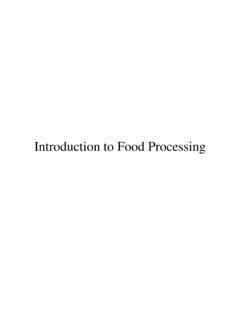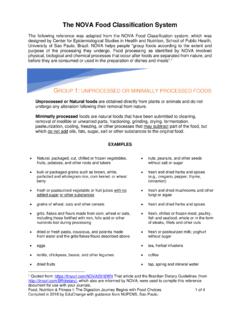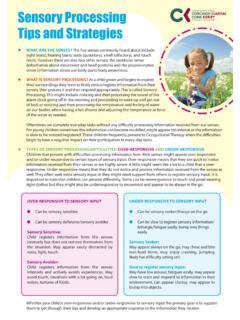Transcription of Ultra-processed foods, diet quality and human health
1 Ultra-processed foods, diet quality , and health using the NOVA classification systemFood and Agriculture Organization of the United Nations Rome, 2019 Prepared by Carlos Augusto MonteiroGeoffrey Cannon Mark LawrenceMaria Laura da Costa LouzadaandPriscila Pereira MachadoRequired citation: Monteiro, , Cannon, G., Lawrence, M., Costa Louzada, and Pereira Machado, P. 2019. Ultra-processed foods, diet quality , and health using the NOVA classification system. Rome, FAO. The designations employed and the presentation of material in this information product do not imply the expression of any opinion whatsoever on the part of the food and Agriculture Organization of the United Nations (FAO) concerning the legal or development status of any country, territory, city or area or of its authorities, or concerning the delimitation of its frontiers or boundaries.
2 The mention of specific companies or products of manufacturers, whether or not these have been patented, does not imply that these have been endorsed or recommended by FAO in preference to others of a similar nature that are not mentioned. The views expressed in this information product are those of the author(s) and do not necessarily reflect the views or policies of FAO, nor do they constitute a validation of the NOVA classification 978-92-5-131701-3 FAO, 2019 Some rights reserved. This work is made available under the Creative Commons Attribution-NonCommercial-ShareAlike IGO licence (CC BY-NC-SA IGO; ).
3 Under the terms of this licence, this work may be copied, redistributed and adapted for non-commercial purposes, provided that the work is appropriately cited. In any use of this work, there should be no suggestion that FAO endorses any specific organization, products or services. The use of the FAO logo is not permitted. If the work is adapted, then it must be licensed under the same or equivalent Creative Commons licence. If a translation of this work is created, it must include the following disclaimer along with the required citation: This translation was not created by the food and Agriculture Organization of the United Nations (FAO).
4 FAO is not responsible for the content or accuracy of this translation. The original [Language] edition shall be the authoritative edition. Disputes arising under the licence that cannot be settled amicably will be resolved by mediation and arbitration as described in Article 8 of the licence except as otherwise provided herein. The applicable mediation rules will be the mediation rules of the World Intellectual Property Organization and any arbitration will be conducted in accordance with the Arbitration Rules of the United Nations Commission on International Trade Law (UNCITRAL).
5 Third-party materials. Users wishing to reuse material from this work that is attributed to a third party, such as tables, figures or images, are responsible for determining whether permission is needed for that reuse and for obtaining permission from the copyright holder. The risk of claims resulting from infringement of any third-party-owned component in the work rests solely with the user. Sales, rights and licensing. FAO information products are available on the FAO website ( ) and can be purchased through Requests for commercial use should be submitted via: Queries regarding rights and licensing should be submitted to.
6 Ultra-processed foods, diet quality , and health using the NOVA classification system Page 1 of 44 Contents Acknowledgements 2 SECTION 1 Introduction 3 SECTION 2 The NOVA food classification system and its four food groups 6 SECTION 3 Ultra-processed foods and the nutritional quality of national diets 13 SECTION 4 Ultra-processed foods and the risk of non-communicable diseases 22 SECTION 5 Conclusions and implications 33 References 38 Annex 1 44 Page 2 of 44 Ultra-processed foods, diet quality , and health using the NOVA classification system Acknowledgements The report Ultra-processed foods, diet quality , and health using the NOVA classification system was prepared by Carlos Augusto Monteiro, Geoffrey Cannon, Mark Lawrence, Maria Laura da Costa Louzada, and Priscila Pereira Machado.
7 Ultra-processed foods, diet quality , and health using the NOVA classification system Page 3 of 44 SECTION 1 Introduction The significance of industrial processing , and in particular techniques and ingredients developed or created by modern food science and technology, on the nature of food and on the state of human health , is generally understated. This is evident in international and national policies and strategies designed to improve population nutrition and health , in dietary recommendations, and in public policies and actions guided by such recommendations.
8 Until recently it has also been neglected in epidemiological and experimental studies concerning diet, nutrition and health . The nature of processing Reports issued by UN agencies and other authoritative organisations (WHO, 2003; WCRF, 2007) list a number of commonly consumed processed foods and drinks as certainly or probably implicated in obesity and various chronic non-communicable diseases. These include energy-dense food products, fast foods , convenience foods , soft drinks, sugary drinks, various refined starchy foods, processed meat and salt-preserved foods.
9 But such reports stop short of examining the common factors in these foods the nature, extent and purpose of the processes used to make them. National dietary guidelines issued by governments of almost all countries, now with some exceptions (Brazilian Ministry of health , 2014; Ministerio de Salud del Uruguay, 2016; Ministerio de Salud Publica del Equador & FAO 2018; Ministerio de Salud del Per 2018), do not address how types of processing affect the nature and quality of foods. As one example, both the official US 2010 and the 2015-2020 Dietary Guidelines for Americans reports (USDA/DHSS, 2010; USDA/DHSS, 2015) advise reduced consumption of critical nutrients commonly in excess in processed foods such as free sugars, sodium and trans fats, but overlook the sources of these nutrients.
10 Also, attention to food additives is almost always confined to important issues of toxicity and other forms of contamination. Little attention is given to the equally important issue of adulteration, including the use of cosmetic food additives (notably, flavours, colours, and emulsifiers) used to make combinations of ingredients such as cheap processed oils, refined sugars and starches, with sodium, palatable and attractive. The relative neglect of food processing is historically understandable. When dietary guidelines were first compiled and published in the first half of the last century, most food was combined with culinary ingredients and consumed in the form of dishes and meals, or was eaten as such.















